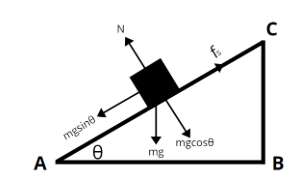
A cubical block of mass $M$ and edge $a$ slides down a rough inclined plane of inclination with uniform velocity. The torque of the normal force on the block about its center has magnitude
1) Zero
2) $Mga$
3) $Mga\operatorname{Sin} \theta $
4) $\dfrac{{Mga\operatorname{Sin} \theta }}{2}$
Answer
559.2k+ views
Hint: Torque is the moment of force. It is the cross product of the force with a perpendicular distance between the axis of rotation and the point of application of force with the force.
Complete step by step solution:
Given that, a cubical block of mass \[ = m\]
And edge length $ = a$ ; take $r = \dfrac{a}{2}$
Angle of inclination is $ = \theta $
The angle that an inclined plane makes with the horizontal when a body is placed on it is in limiting equilibrium; this angle is called angle of repose.

When a cubical block is placed on a rough surface of angle $\theta $ and block slide. Then we have
$F = mg\sin \theta $ …………...(1)
because the force applied is just opposite to the $mg\sin \theta $ similar for normal reaction, When a body is pressed against a surface, the body experiences a force which is perpendicular to the surface.
$N = mg\cos \theta $ ……………..(2)
There are two components, $mg\cos \theta $ and $mg\sin \theta $ but torque is produced only in$mg\sin \theta $ because$mg\cos \theta $ and $N$ pass through the center of the cube, there will be no torque. And
$\overrightarrow \tau = \overrightarrow r \times \overrightarrow F $ ………….(3)
$\tau = rF\sin \theta $
Putting the value of equation (1) in equation (3),
We get,
$\overrightarrow \tau = mg\sin \theta \times \left( {\dfrac{a}{2}} \right)$
Or we can write as,
$\overrightarrow \tau = \dfrac{{mg\sin \theta \times a}}{2}$
Hence, the correct option is (4)
Note: Some point about normal reaction when a block is placed on a table, the normal reaction on the block by the table is $N = mg$ but when block is placed on an inclined plane the normal reaction force, $N = mg\cos \theta $
Complete step by step solution:
Given that, a cubical block of mass \[ = m\]
And edge length $ = a$ ; take $r = \dfrac{a}{2}$
Angle of inclination is $ = \theta $
The angle that an inclined plane makes with the horizontal when a body is placed on it is in limiting equilibrium; this angle is called angle of repose.

When a cubical block is placed on a rough surface of angle $\theta $ and block slide. Then we have
$F = mg\sin \theta $ …………...(1)
because the force applied is just opposite to the $mg\sin \theta $ similar for normal reaction, When a body is pressed against a surface, the body experiences a force which is perpendicular to the surface.
$N = mg\cos \theta $ ……………..(2)
There are two components, $mg\cos \theta $ and $mg\sin \theta $ but torque is produced only in$mg\sin \theta $ because$mg\cos \theta $ and $N$ pass through the center of the cube, there will be no torque. And
$\overrightarrow \tau = \overrightarrow r \times \overrightarrow F $ ………….(3)
$\tau = rF\sin \theta $
Putting the value of equation (1) in equation (3),
We get,
$\overrightarrow \tau = mg\sin \theta \times \left( {\dfrac{a}{2}} \right)$
Or we can write as,
$\overrightarrow \tau = \dfrac{{mg\sin \theta \times a}}{2}$
Hence, the correct option is (4)
Note: Some point about normal reaction when a block is placed on a table, the normal reaction on the block by the table is $N = mg$ but when block is placed on an inclined plane the normal reaction force, $N = mg\cos \theta $
Recently Updated Pages
How to write the formula of calcium carbonate using class 11 chemistry CBSE

Differentiate between plasmolysis and deplasmolysi class 11 biology CBSE

What are the oxidation states of copper class 11 chemistry CBSE

How is ethane prepared in the laboratory class 11 chemistry CBSE

What is the difference between uniform linear motion class 11 physics CBSE

How to calculate the equivalent weight of copper s class 11 chemistry CBSE

Trending doubts
What is meant by exothermic and endothermic reactions class 11 chemistry CBSE

10 examples of friction in our daily life

One Metric ton is equal to kg A 10000 B 1000 C 100 class 11 physics CBSE

1 Quintal is equal to a 110 kg b 10 kg c 100kg d 1000 class 11 physics CBSE

Difference Between Prokaryotic Cells and Eukaryotic Cells

What are Quantum numbers Explain the quantum number class 11 chemistry CBSE




